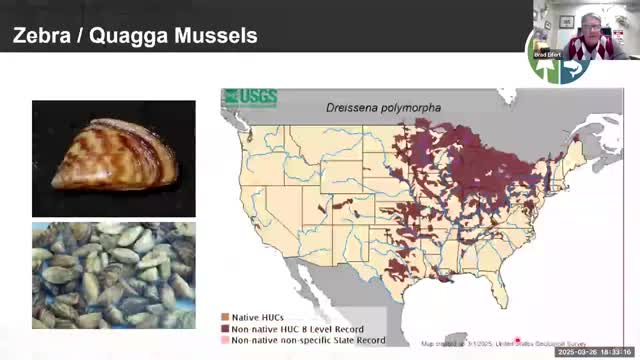Nebraska officials warn anglers on zebra mussels and carp management
January 01, 2025 | Nebraska Game and Parks Commission (NGPC), State Agencies, Organizations, Executive, Nebraska
This article was created by AI summarizing key points discussed. AI makes mistakes, so for full details and context, please refer to the video of the full meeting. Please report any errors so we can fix them. Report an error »

As the sun dipped below the horizon, casting a warm glow over the Nebraska landscape, fisheries experts gathered for the Nebraska South-Central District Fisheries Meeting 2025. The atmosphere buzzed with anticipation as attendees prepared to discuss pressing issues affecting the state's aquatic ecosystems.
One of the primary concerns highlighted was the ongoing battle against invasive species, particularly zebra mussels. While Nebraska has been fortunate to keep these pests largely at bay, they have infiltrated the eastern regions, including the Missouri River System and some isolated lakes near Omaha. Experts urged anglers to take precautions when returning from fishing trips in neighboring states like Kansas and South Dakota, emphasizing the importance of cleaning boats to prevent the spread of these invasive species.
The meeting also addressed the alarming presence of silver and bighead carp, which have been detected moving up the Platte and Loop Rivers. A recent discovery of a dead carp near North Platte raised concerns about their expanding range. Attendees were advised to be vigilant and to report any sightings of larval Asian carp, as these fish pose a significant threat to local ecosystems.
Another invasive species, Eurasian water milfoil, was discussed as a growing problem in several lakes across the district. This dense aquatic vegetation not only complicates fishing but also threatens native plant species. Fisheries officials are planning treatments in affected lakes to curb its spread and maintain the health of Nebraska's waterways.
The meeting also provided valuable insights into local fishing opportunities. Attendees learned about various public access points along the Platte River, ideal for catfish angling, and were encouraged to utilize resources like public atlases to find the best spots. The discussion included recommendations for targeting both largemouth and smallmouth bass, with specific lakes highlighted for their robust populations.
As the meeting wrapped up, fisheries staff encouraged open communication with the public, inviting anglers to reach out with questions or concerns. The collaborative spirit of the gathering underscored a shared commitment to preserving Nebraska's aquatic resources for future generations. With ongoing monitoring and community involvement, there is hope that the state's fisheries can continue to thrive amidst the challenges posed by invasive species and environmental changes.
One of the primary concerns highlighted was the ongoing battle against invasive species, particularly zebra mussels. While Nebraska has been fortunate to keep these pests largely at bay, they have infiltrated the eastern regions, including the Missouri River System and some isolated lakes near Omaha. Experts urged anglers to take precautions when returning from fishing trips in neighboring states like Kansas and South Dakota, emphasizing the importance of cleaning boats to prevent the spread of these invasive species.
The meeting also addressed the alarming presence of silver and bighead carp, which have been detected moving up the Platte and Loop Rivers. A recent discovery of a dead carp near North Platte raised concerns about their expanding range. Attendees were advised to be vigilant and to report any sightings of larval Asian carp, as these fish pose a significant threat to local ecosystems.
Another invasive species, Eurasian water milfoil, was discussed as a growing problem in several lakes across the district. This dense aquatic vegetation not only complicates fishing but also threatens native plant species. Fisheries officials are planning treatments in affected lakes to curb its spread and maintain the health of Nebraska's waterways.
The meeting also provided valuable insights into local fishing opportunities. Attendees learned about various public access points along the Platte River, ideal for catfish angling, and were encouraged to utilize resources like public atlases to find the best spots. The discussion included recommendations for targeting both largemouth and smallmouth bass, with specific lakes highlighted for their robust populations.
As the meeting wrapped up, fisheries staff encouraged open communication with the public, inviting anglers to reach out with questions or concerns. The collaborative spirit of the gathering underscored a shared commitment to preserving Nebraska's aquatic resources for future generations. With ongoing monitoring and community involvement, there is hope that the state's fisheries can continue to thrive amidst the challenges posed by invasive species and environmental changes.
View full meeting
This article is based on a recent meeting—watch the full video and explore the complete transcript for deeper insights into the discussion.
View full meeting
